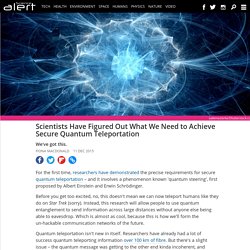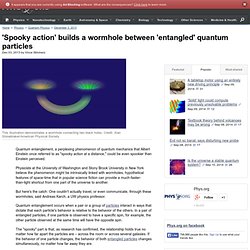

Scientists have figured out what we need to achieve secure quantum teleportation. For the first time, researchers have demonstrated the precise requirements for secure quantum teleportation – and it involves a phenomenon known 'quantum steering', first proposed by Albert Einstein and Erwin Schrödinger.

Before you get too excited, no, this doesn't mean we can now teleport humans like they do on Star Trek (sorry). Instead, this research will allow people to use quantum entanglement to send information across large distances without anyone else being able to eavesdrop. Which is almost as cool, because this is how we'll form the un-hackable communication networks of the future. Quantum teleportation isn't new in itself. Researchers have already had a lot of success quantum teleporting information over 100 km of fibre. "Teleportation works like a sophisticated fax machine, where a quantum state is transported from one location to another," said one of the researchers, Margaret Reid, from Swinburne University of Technology in Australia.
Spooky quantum connection quantified for multiple particles. A first-of-its-kind measurement has quantified a mysterious quantum bond shared by several particles rather than just two.

The experiment, reported in the Dec. 3 Nature, brings physicists closer to understanding the true scope of this link, known as quantum entanglement. Entanglement interweaves particles’ fates so that some of each particle’s properties, which are inherently uncertain according to quantum mechanics, are tied to those of its partners. Each particle essentially sacrifices its individuality to become part of an umbrella entangled state. While physicists have developed reliable methods for detecting entanglement between pairs of particles, the measurements get tricky when three or more particles are involved. 'Spooky action' builds a wormhole between 'entangled' quantum particles. Quantum entanglement, a perplexing phenomenon of quantum mechanics that Albert Einstein once referred to as "spooky action at a distance," could be even spookier than Einstein perceived.

Physicists at the University of Washington and Stony Brook University in New York believe the phenomenon might be intrinsically linked with wormholes, hypothetical features of space-time that in popular science fiction can provide a much-faster-than-light shortcut from one part of the universe to another. But here's the catch: One couldn't actually travel, or even communicate, through these wormholes, said Andreas Karch, a UW physics professor. Quantum entanglement occurs when a pair or a group of particles interact in ways that dictate that each particle's behavior is relative to the behavior of the others. In a pair of entangled particles, if one particle is observed to have a specific spin, for example, the other particle observed at the same time will have the opposite spin.
1401.7983v1. Squeeze light to teleport quantum energy - physics-math - 23 January 2014. Putting the squeeze on light may be the key to teleporting energy across vast distances.

Although the amount of energy that could theoretically be transmitted is tiny for now, it could be enough to power quantum computers that don't overheat. For years physicists have been smashing distance records for quantum teleportation, which exploits quantum entanglement to send encrypted information. Entangled particles remain linked no matter how far apart they are, and a change to one particle always affects its partner in a particular way.
In experiments, for example, a pair of entangled particles is separated and each partner is sent to a different location. When someone measures the particle at point A, its quantum state is decided and that event immediately causes a corresponding change in the particle at point B. No physical matter is transmitted, and nothing is travelling faster than light. Physicists have done this with light and with matter, such as entangled ions. Real-Time Imaging of Quantum Entanglement. 1310.4691v1. This essentially would be. This may solve Einstein's. Quantum Entanglement Could Stretch Across Time. In the weird world of quantum physics, two linked particles can share a single fate, even when they’re miles apart. Now, two physicists have mathematically described how this spooky effect, called entanglement, could also bind particles across time.
If their proposal can be tested, it could help process information in quantum computers and test physicists’ basic understanding of the universe. “You can send your quantum state into the future without traversing the middle time,” said quantum physicist S. Jay Olson of Australia’s University of Queensland, lead author of the new study. In ordinary entanglement, two particles (usually electrons or photons) are so intimately bound that they share one quantum state — spin, momentum and a host of other variables — between them.
Physicists have figured out how to use entanglement to encrypt messages in uncrackable codes and build ultrafast computers. Olson explained them with a Star Trek analogy. “It stimulated our imaginations,” said Fuentes. This actually coincides with.